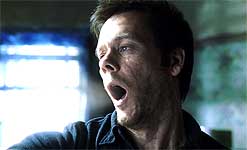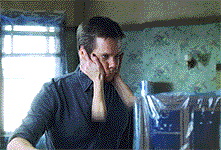


Tom shudders in pain as Samantha's energy enters his body, making his face go pale, revealing his veins and arteries. Artist Hitoshi Inoue tracked and animated layers of Photoshop-painted veins.
|
Synchronized digital breath bursts and subtle vapors --like the CG vapor rising between Sam and Tom's outstretched hands in the flashback living room-- were not the only tracking and roto challenges. For a series of cuts in both the flashback living room and the basement, BFTR had to create the look of Tom's skin going translucent as he experiences Samantha's death, his veins showing through as the translucency travels up his arm and into his face. Hitoshi, Alec and Josh tackled the three vein shots on the Mac, creating layers of vein patterns in Photoshop and then tracking, rotoing and revealing them in After Effects. Rather than just wiping the patterns on, the two artists feathered their vein edges and used shifting contrast controls on their mattes to allow the veins to "grow" on and thicken as they became more visible.
Meanwhile, artist Martha Soehendra was tackling the morphing elements for two of the more spectacular transition shots: the living room transformation from daylight flashback to nighttime present as Maggie literally yanks Tom back into reality, and the "eyeglass" transition as Tom begins to fully experience the event of Samantha's death. Both shots required Martha to first hand-roto and then seamlessly blend disparate pairs of elements in order to provide the basis for the final composites.

Pulling Tom from the past to the present, Maggie's arms reach out and bring him back to reality. This complicated shot required extensive, accurate rotoscoping and a seamless morph, performed by the BFTR digital team. Click here to view a Quicktime movie of the shot. (450k)
|
The former was originally storyboarded as a shot from Tom's POV of Samantha disappearing into the floor as the room changed around her, but during production David came up with the idea of seeing Maggie's disembodied hands reach in to grab Tom's face, breaking the dead girl's spell over him. The two main plates were shot a week apart to accommodate the redressing of the set, and under Casey's supervision the camera was placed as close to the same position and height as possible; however, the actors were not as easy to match, so a successful morph between elements shot with the appropriate lighting changes was essential to making it look like a single, continuous shot. Both Tom and Maggie had to be cleanly roto'd from the background in both plates, with Maggie additionally matted to reveal only her arms in the first plate; Martha then used Elastic Reality on the Mac to blend the two sets of images together. For the final composite, the fact that the two background plates differed slightly in position and size proved to be a blessing in disguise by enabling Van to create the illusion of a slightly craning camera as the transition occurred. To create the visual equivalent of Tom's clouded flashback vision evaporating back to reality, Gunther created a dissipating cloud element in Alias, which Van then used as an animated matte to move from one background to another. The last challenge on the shot was that since the completed shot started in one lighting scheme and ended in another, the surrounding scenes had to be finaled in color timing and that timing matched in the two sides of the transition before BFTR's final shot could be rendered.
The eyeglass transition was always one of David's key shots, and the challenge there was not only to create a successful morph centered around the eyes, but to do so with plates that were shot weeks apart with different lighting, lenses, facial features and composition. And of course, the fact that Sam wears glasses and Tom does not made it all the more challenging; Martha had to isolate the glasses and morph the faces around them, then composite the glasses back on top, with an emphasis on bringing the glasses into the shot earlier on Tom so that the transition didn't all take place at once and just look like a morph. An added challenge was that the tungsten basement lighting was far yellower than the outdoor daylight, so Tom's face was paled quite a bit during the first part of the push-in to create a closer match. Digital breath elements were added by Todd to complete the shot.
For Samantha's final death POV, Van took a 950-frame shot of her two killers staring down at the camera and gradually shrank the image in a soft vignette, adding image streaking to the edges and positioning the image so that it dissolved into Kevin's face in the final film.

To transition from the present to the past, the camera moves into Tom's eyes, which turn into Samantha's. Artist Martha Soehendra used Elastic Reality and After Effects to create the transition, while Todd Vaziri added breath elements to the shot. Click here to view a Quicktime movie of the shot. (750k Quicktime)
|
BFTR's final shot for STIR was also its longest one: a 1400-frame crane shot in which Samantha's spirit, now at peace, appears in three separate places in the same shot as the camera tilts/pans and then cranes up to follow the ghost as she walks off into the night. Improvised on the set by David, DP Fred Murphy and Casey, the shot was filmed in a single continuous take, with the camera stopping but still rolling in key parts of the shot in order to allow the actress to run from one position to another. After Van created a proof-of-concept temp composite on video, artist Todd Vaziri took on the task of creating a seamless shot in which the camera pans up to see Samantha in a window, then pans down to see her again on the sidewalk as she puts on her glasses, then pans again to see her putting on her jacket and walking out into the street and disappearing as a car passes through her. Apart from the intricate mattes and tracking involved in making the pans short and seamless between the Sams, Todd also had the challenge of changing the timing of the car's entrance... while the camera is craning up and the perspective is shifting! David wanted the car to enter frame and turn the corner much sooner than originally shot, so Todd had to isolate the car and create both a new perspective shift and headlight interactions in the street to match the new pacing. The extensive roto challenges for this shot, as well as the many paint fixes accomplished throughout the film, were tackled with Puffin Designs' Commotion on the Mac.
In all, BFTR contributed some 35 visual effects shots for the film, including a pair of digital video insert fixes and an articulated iris shot of Tom's POV as he closes his eyes and goes under hypnosis. BFTR also had the fun of adding a greenscreen element of Samantha to footage from the children's TV classic "Lidsville." The locked-off Sam element was shot before the specific Lidsville shot was chosen, but it had to be completed and available on set for video playback within a week of being shot. Rather than choosing a simple lockoff shot from the show, Van decided to use an undercranked tracking shot, digitally panning and resizing Samantha as she came into shot and turned to look at the camera. The "Lidsville" footage had been shot on videotape in the 1970's and had that characteristic soft look that had to be matched for the video transferred film footage of Sam.
For the variety of effects work on STIR OF ECHOES, the BFTR team were able to rely heavily on the artists' skill with Adobe After Effects and Puffin Designs' Commotion on the Mac, with some key pinch-hits from the Alias/Maya side. When faced with the all-too-common spectre of a low budget and shades of mortality, the artists of BFTR refused to be spooked and were able to provide the spirited creativity necessary to give the film a ghost of a chance in the chill-filled fall feature marketplace.
|
|


Written for the Screen and Directed by DAVID KOEPP
Based on the novel by RICHARD MATHESON
©1999 Artisan Entertainment
http://www.stirofechoes.com |
Visual Effects and Video Displays by
BANNED FROM THE RANCH ENTERTAINMENT
| Visual Effects Supervisors |
|
VAN LING
CASEY CANNON |
| Visual Effects Production Manager |
|
KERRY SHEA |
| Visual Effects Coordinator |
|
BRENT COERT |
| Lead Digital Artist |
|
TODD VAZIRI |
Digital Artists
HITOSHI INOUE
GUNTHER SCHATZ |
|
ALEC BARTSCH
JOSH SAETA
MARTHA SOEHENDRA
|
| Visual Effects Editor |
|
DEBRA SANDERSON |
| Playback Supervisor |
|
GLENN CANNON |
| Technical Supervisor |
|
DERICK TORTORELLA |
| Technical Director |
|
TRAVIS LANGLEY |
| I/O Coordinator |
|
FRED LACAYANGA |
| Office Administrator |
|
MARGARITA MEZA |
|
|
|

Banned From The Ranch Entertainment Home Page
����General Information: info@bftr.com
|




